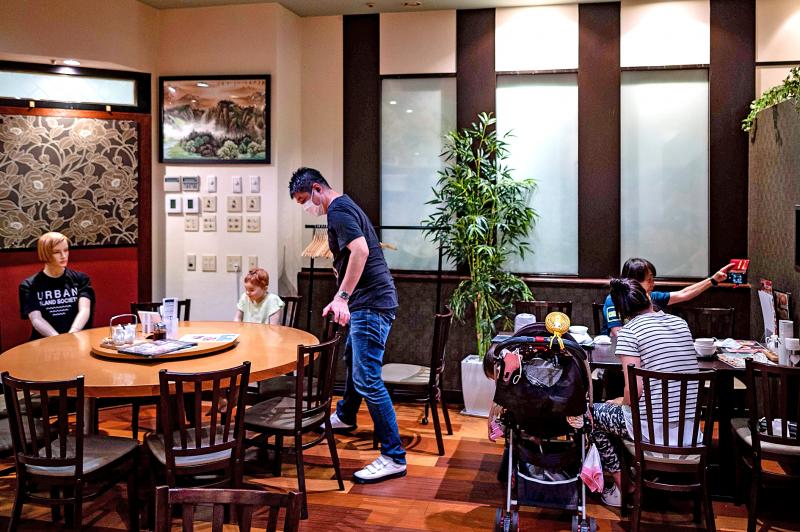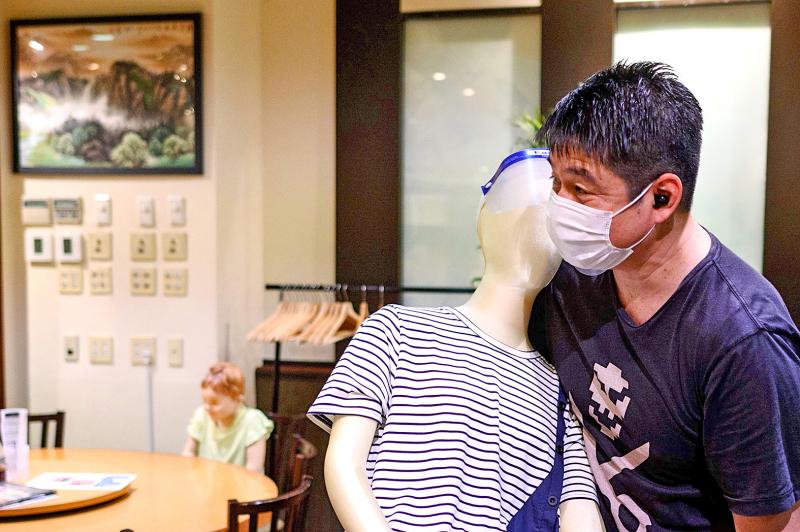The coronavirus pandemic might have left many restaurants empty, but one establishment in Tokyo is relying on some model customers to enforce social distancing: life-like mannequins keeping diners from getting too close.
Masato Takemine’s Chinese restaurant looks busy even as many businesses in the city deal with a dearth of clientele, with ladies in ornate Chinese-style dresses and a girl in a kimono among those seated at his tables.
But the 16 customers are actually mannequins he has placed randomly at tables to keep diners from getting too close.

Photo: AFP
“At first I removed some of the tables to have more space in between, but it then looked so lonely, as if the restaurant was under renovation,” Takemine said.
“With these mannequins, the restaurant looks busy from the outside, and I can make sure customers are distancing themselves. “It’s also fun, giving us a jolly feeling,” he giggled.
While Japan has avoided the devastating tolls in places hit hardest by the coronavirus, many restaurants shut their doors during a state of emergency and even after it was lifted in May, the industry has seen customers shun eating out.

Photo: AFP
Takemine’s restaurant Kirin Saikan in downtown Tokyo reopened in late May but sees about half the number the customers it did before the virus, he said.
Among those returning was 51-year-old Tetsuya Kimura, who said he was startled when he walked through the entrance curtains for the first time after the reopening and saw the mannequins.
“These dolls look so real that I need some time to get used to them,” he said, tucking into a bowl of noodles at a table he was sharing with a child mannequin.
Takeichi Otomo, 82, another frequent customer at the restaurant, said he struggled to not look too shocked at the beginning.
“I still get startled when I come here,” he said with a straight face. “This is a crazy idea!”
While the mannequins keep the restaurant from feeling too empty, Takemine said he often thinks with longing about when his customers could visit with family and friends and enjoy carefree laughs and chats over platters to share.
“I don’t think we can go back to those times for many months,” he said. “I am just hoping we will return to normal while creating an environment where people can eat and drink safely.”

Many people noticed the flood of pro-China propaganda across a number of venues in recent weeks that looks like a coordinated assault on US Taiwan policy. It does look like an effort intended to influence the US before the meeting between US President Donald Trump and Chinese dictator Xi Jinping (習近平) over the weekend. Jennifer Kavanagh’s piece in the New York Times in September appears to be the opening strike of the current campaign. She followed up last week in the Lowy Interpreter, blaming the US for causing the PRC to escalate in the Philippines and Taiwan, saying that as

US President Donald Trump may have hoped for an impromptu talk with his old friend Kim Jong-un during a recent trip to Asia, but analysts say the increasingly emboldened North Korean despot had few good reasons to join the photo-op. Trump sent repeated overtures to Kim during his barnstorming tour of Asia, saying he was “100 percent” open to a meeting and even bucking decades of US policy by conceding that North Korea was “sort of a nuclear power.” But Pyongyang kept mum on the invitation, instead firing off missiles and sending its foreign minister to Russia and Belarus, with whom it

The Chinese Communist Party (CCP) has a dystopian, radical and dangerous conception of itself. Few are aware of this very fundamental difference between how they view power and how the rest of the world does. Even those of us who have lived in China sometimes fall back into the trap of viewing it through the lens of the power relationships common throughout the rest of the world, instead of understanding the CCP as it conceives of itself. Broadly speaking, the concepts of the people, race, culture, civilization, nation, government and religion are separate, though often overlapping and intertwined. A government

Nov. 3 to Nov. 9 In 1925, 18-year-old Huang Chin-chuan (黃金川) penned the following words: “When will the day of women’s equal rights arrive, so that my talents won’t drift away in the eastern stream?” These were the closing lines to her poem “Female Student” (女學生), which expressed her unwillingness to be confined to traditional female roles and her desire to study and explore the world. Born to a wealthy family on Nov. 5, 1907, Huang was able to study in Japan — a rare privilege for women in her time — and even made a name for herself in the